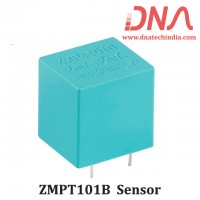Capacitance and Charge |
||
|
We saw in the previous tutorials that a Capacitor consists of two parallel conductive plates (usually a metal) which are prevented from touching each other (separated) by an insulating material called the "dielectric". We also saw that when a voltage is applied to these plates an electrical current flows charging up one plate with a positive charge with respect to the supply voltage and the other plate with an equal and opposite negative charge. Then, a capacitor has the ability of being able to store an electrical charge Q (units in Coulombs) of electrons. When a capacitor is fully charged there is a potential difference, p.d. between its plates, and the larger the area of the plates and/or the smaller the distance between them (known as separation) the greater will be the charge that the capacitor can hold and the greater will be its Capacitance. |
||
|
The Capacitors ability to store this electrical charge (Q) between its plates is proportional to the applied voltage, V for a capacitor of known capacitance in Farads. Capacitance C is always positive. The greater the applied voltage the greater will be the charge stored on the plates of the capacitor. Likewise, the smaller the applied voltage the smaller the charge. Therefore, the actual charge Q on the plates of the capacitor and can be calculated as: |
||
|
|
||
Charge on a Capacitor |
||
|
Q = C x V Coulombs |
||
|
transposing the above equation gives us: |
||
|
C = Q/V or V = Q/C |
||
|
Units of: Q measured in Coulombs, V in volts and C in Farads. |
||
|
|
||
|
Then from above we can define the unit of Capacitance as being a constant of proportionality being equal to the coulomb/volt which is also called a Farad, unit F. As capacitance represents the capacitors ability (capacity) to store an electrical charge on its plates we can define one Farad as the "capacitance of a capacitor which requires a charge of one coulomb to establish a potential difference of one volt between its plates" as firstly described by Michael Faraday. So the larger the capacitance, the higher is the amount of charge stored on a capacitor for the same amount of voltage. |
||
|
The ability of a capacitor to store a charge on its conductive plates gives it its Capacitance value. Capacitance can also be determined from the dimensions or area, A of the plates and the properties of the dielectric material between the plates. A measure of the dielectric material is given by the permittivity, ( ε ), or the dielectric constant. So another way of expressing the capacitance of a capacitor is; |
||
|
|
||
with Air as its dielectric |
||
|
C = Q/V = ε(A/d) |
||
with a Solid as its dielectric |
||
|
C = Q/V = ε0 εr (A/d) |
||
|
where A is the area of the plates in square metres, m2 with the larger the area, the more charge the capacitor can store. d is the distance or separation between the two plates. The smaller is this distance, the higher is the ability of the plates to store charge, since the -ve charge on the -Q charged plate has a greater effect on the +Q charged plate, resulting in more electrons being repelled off of the +Q charged plate, and thus increasing the overall charge. ε0 (epsilon) is the value of the permittivity for air which is 8.84 x 10-12 F/m, and εr is the permittivity of the dielectric medium used between the two plates. |
||
|
|
||
Parallel Plate Capacitor |
||
|
|
||
|
We have said previously that the capacitance of a parallel plate capacitor is proportional to the surface area A and inversely proportional to the distance, d between the two plates and this is true for dielectric medium of air. However, the capacitance value of a capacitor can be increased by inserting a solid medium in between the conductive plates which has a dielectric constant greater than that of air. Typical values of epsilon ε for various commonly used dielectric materials are: Air = 1.0, Paper = 2.5 - 3.5, Glass = 3 - 10, Mica = 5 - 7 etc. |
||
|
The factor by which the dielectric material, or insulator, increases the capacitance of the capacitor compared to air is known as the Dielectric Constant, k. k is the ratio of the permittivity of the dielectric medium being used to the permittivity of free space otherwise known as a vacuum. Therefore, all the capacitance values are related to the permittivity of vacuum. A dielectric material with a high dielectric constant is a better insulator than a dielectric material with a lower dielectric constant. Dielectric constant is a dimensionless quantity since it is relative to free space. |
||
|
|
||
Example No1 |
||
|
A parallel plate capacitor consists of two plates with a total surface area of 100 cm2. What will be the capacitance in pico-Farads, (pF) of the capacitor if the plate separation is 0.2 cm, and the dielectric medium used is air. |
||
|
|
||
|
then the value of the capacitor is 44pF. |
||
|
|
||
Charging & Discharging of a Capacitor |
||
|
Consider the following circuit. |
||
|
|
||
|
Assume that the capacitor is fully discharged and the switch connected to the capacitor has just been moved to position A. The voltage across the 100uf capacitor is zero at this point and a charging current ( i ) begins to flow charging up the capacitor until the voltage across the plates is equal to the 12v supply voltage. The charging current stops flowing and the capacitor is said to be "fully-charged". |
||
|
Once the capacitor is "fully-charged" in theory it will maintain its state of voltage charge even when the supply voltage has been disconnected as they act as a sort of temporary storage device. However, while this may be true of an "ideal" capacitor, a real capacitor will slowly discharge itself over a long period of time due to the internal leakage currents flowing through the dielectric. This is an important point to remember as large value capacitors connected across high voltage supplies can still maintain a significant amount of charge even when the supply voltage is switched "OFF". |
||
|
If the switch was disconnected at this point, the capacitor would maintain its charge indefinitely, but due to internal leakage currents flowing across its dielectric the capacitor would very slowly begin to discharge itself as the electrons passed through the dielectric. The time taken for the capacitor to discharge down to 37% of its supply voltage is known as its Time Constant. |
||
|
If the switch is now moved from position A to position B, the fully charged capacitor would start to discharge through the lamp now connected across it, illuminating the lamp until the capacitor was fully discharged as the element of the lamp has a resistive value. The brightness of the lamp and the duration of illumination would ultimately depend upon the capacitance value of the capacitor and the resistance of the lamp (t = C x R). The larger the value of the capacitor the brighter and longer will be the illumination of the lamp as it could store more charge. |
||
|
|
||
Example No2 |
||
|
Calculate the charge in the above capacitor circuit. |
||
|
|
||
|
then the charge on the capacitor is 1.2 millicoulombs. |
||
|
|
||
Current through a Capacitor |
||
|
The current that flows through a capacitor is directly related to the charge on the plates as current is the rate of flow of charge with respect to time. As the capacitors ability to store charge (Q) between its plates is proportional to the applied voltage (V), the relationship between the current and the voltage that is applied to the plates of a capacitor becomes: |
||
Current-voltage Relationship |
||
|
|
||
| As the voltage across the plates increases (or decreases) over time, the current flowing through the capacitance deposits (or removes) charge from its plates with the amount of charge being proportional to the applied voltage. Then both the current and voltage applied to a capacitance are functions of time and are denoted by the symbols, i(t) and v(t) However, from the above equation we can also see that if the voltage remains constant, the charge will become constant and therefore the current will be zero!. In other words, no change in voltage, no movement of charge and no flow of current. This is why a capacitor appears to "block" current flow when connected to a steady state DC voltage. | ||
|
|
||
The Farad |
||
|
We now know that the ability of a capacitor to store a charge gives it its capacitance value C, which has the unit of the Farad, F. But the farad is an extremely large unit on its own making it impractical to use, so submultiple's or fractions of the standard Farad unit are used instead. To get an idea of how big a Farad really is, the surface area of the plates required to produce a capacitor with a value of one Farad with a reasonable plate separation of just 1mm operating in a vacuum and rearranging the equation for capacitance above would be: |
||
|
A = Cd ÷ 8.85pF/m = (1 x 0.001) ÷ 8.85x10-12 = 112,994,350 m2 |
||
|
or 113 million m2 which would be equivalent to a plate of more than 10 kilometres x 10 kilometres square. |
||
|
Then capacitors which have a value of one Farad are very rare and have a solid dielectric. As one Farad is such a large and an unpractical unit to use, prefixes are used instead in electronic formulas with component values given in micro-Farads (μF), nano-Farads (nF) and the pico-Farads (pF). For example: |
||
|
|
||
Sub-units of the Farad |
||
|
|
||
|
Convert the following capacitance values from a) 22nF to uF, b) 0.2uF to nF, c) 550pF to uF. |
||
|
a) 22nF = 0.022uF b) 0.2uF = 200nF c) 550pF = 0.00055uF |
||
|
|
||
Energy |
||
|
When a capacitor charges up from the power supply connected to it, an electrostatic field is established which stores energy in the capacitor. The amount of energy in Joules that is stored in this electrostatic field is equal to the energy the voltage supply exerts to maintain the charge on the plates of the capacitor and is given by the formula: |
||
|
|
||
|
so the energy stored in the 100uF capacitor circuit above is calculated as: |
||
 |
||
|
The next tutorial in our section about Capacitors, we look at Capacitor Colour Codes and the different ways that the value of the capacitor is marked onto its body. |
||
|
|
||
| Reproduced with permission from Wayne Storr | ||
| ( http://www.electronics-tutorials.ws/capacitor/cap_4.html ) | ||











